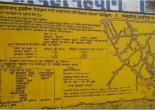- Skip to main content
- Skip to navigation
- Screen Reader Access
- Text Size
- Select Theme Default Theme Yellow Theme Pink Theme Blue Theme
- हिंदी में
- Home
- About Uttarakhand
About Uttarakhand
Uttarakhand came in to existence as 27th states on the political map of India (November, 2000) and due to its geographic and strategic location, it has been given ‘special category status’ by Union of India. Uttarakhand borders China in the north-east and Nepal to the south-east while its neighbouring states are Himachal Pradesh and Uttar Pradesh. The topography of Uttarakhand is characterised by hilly terrain, rugged and rocky mountains, deep valleys, high peaks, sharp stream and rivulets, rapid soil erosion, frequent land slides and widely scattered population. The temperature ranges from 160 C to 400 C but it drops below freezing point in many parts of high mountain areas during winter.
The state comprises of 13 districts namely Almora, Bageshwar, Chamoli, Champawat, Dehradun, Haridwar, Nainital, Pauri Garhwal, Pithoragarh, Rudraprayag, Tehri Garhwal, Udham Singh Nagar and Uttarkashi. There are 78 Tehsils, 95 development blocks, 7227 Gram Panchayats and 16826 villages (39142 habitations). The total population of the State is 10.11 Million as per 2011 Census of which 7.025 Million (69.49%) live in the rural areas. The total area of the State is 53483 Sq. Km. out of which 87% falls in the hills and 13% in the plains. Uttarakhand is very rich in forest having coverage area of 35651 Sq. Km of which nearly 55 % is concentrated in Uttarkashi, Chamoli, Pauri Garhwal and Tehri Garhwal. The average population density per sq. km of the State is 189, however, it ranges between 41 (Uttarkashi) to 817 (Haridwar).
In 1999, India sought to decentralize the delivery of rural water supply and sanitation services. Henceforth communities would choose the service they wanted and were willing to pay for. They would also plan, construct and maintain their own systems, while the government’s role would change from being a ‘water service provider’ to a ‘facilitator’. Uttarakhand has now become the first state in India to implement this decentralized approach in both letter and spirit across its entire territory. In keeping with the 73rd Amendment of the Constitution, it has transferred the control of ‘funds, functions and functionaries’ to the lowest rung of the local governance infrastructure, the Gram Panchayats.
The degree of difficulty in accessing rural water supply and sanitation services are extremely high in the hilly regions of the State. The RWSS sector performance in the State as on 1-4-2013 according to IMIS website of Ministry of Drinking Water & Sanitation, the drinking water supply status in the State is as below:
Table 1: Water Supply Coverage
| Total habitations | Ach. 12-13 | Status as on 1-4-13 | Category wise status of habitations | |||||
| Water Quality affected | > 0 and < 25% | > 25 and < 50% | > 50 and < 75% | > 75 and < 100% | 100% Population Coverage | |||
| 39142 | 983 | 38159 | 15 | 3939 | 2233 | 2149 | 2830 | 26993 |






